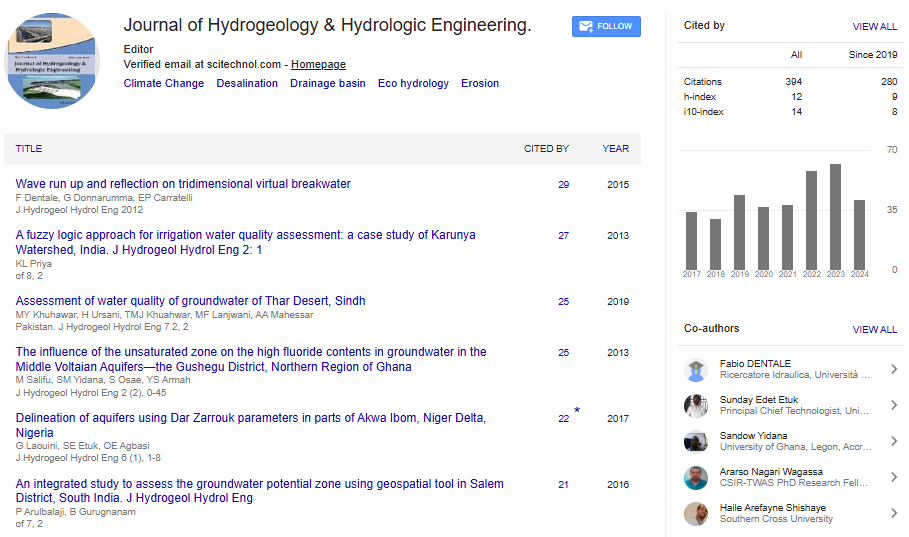Commentary, J Hydrogeol Hydrol Eng Vol: 0 Issue: 0
Geochemical Tracing of Potential Hydraulic Connections between Groundwater
Tarcio Rocha*
Newcastle University, School of Engineering, Newcastle upon Tyne, NE1 7RU, United Kingdom
*Corresponding author: Tarcio Rocha, Newcastle University, School of Engineering, Newcastle upon Tyne, NE1 7RU, United Kingdom, Tel: +123586577446; E-mail: tarcio_r@gmail.com
Received date: 01 July, 2021; Accepted date: 16 July, 2021; Published date: 25 July, 2021
Keywords: Surface Water Hydrology Ground Water Quality & Analysis Erosion and Sedimentation Control Vadose Zone Hydrology
Commentary
A drainage area is a district of land wherever water from rain or snow soften drains downhill into a body of water like a stream, lake, land or ocean. The drainage area includes each the streams and rivers that convey the water still because the land surface from that water drains into those channels.
Hydrology is that the scientific study of the movement, distribution, and management of water on Earth and different planets, together with the water cycle, water resources, and environmental watershed property. A professional of geophysical science is termed a hydrologist. Hydrologists are scientists finding out earth or bionomics, civil or environmental engineering, and physiography. Victimisation varied analytical strategies and scientific techniques, they collect and analyse knowledge to assist solve water connected issues like environmental preservation, natural disasters, and water management.
Hydrology subdivides into surface water geophysical science, groundwater geophysical science (hydrogeology), and marine geophysical science. Domains of geophysical science embody hydrometeorology, surface geophysical science, hydrogeology, drainage-basin management, and water quality, wherever water plays the central role.
Oceanography and meteorology aren't enclosed as a result of water is simply one amongst several necessary aspects inside those fields.
Ground water is water below Earth's surface, typically pumped up for beverage. Groundwater geophysical science (hydrogeology) considers quantifying groundwater flow and matter transport. Issues in describing the saturated zone embody the characterization of aquifers in terms of flow direction, groundwater pressure and, by abstract thought, groundwater depth. Measurements here is created employing a measuring instrument. Aquifers are delineate in terms of hydraulic physical phenomenon, storativity and transmissivity. There are variety of geology strategies for characterising aquifers. There are issues in characterising the vadose zone.
A drainage area is a district of land wherever water from rain or snow soften drains downhill into a body of water like a stream, lake, land or ocean. The drainage area includes each the streams and rivers that convey the water still because the land surface from that water drains into those channels. Used because the basis for DEP drainage area mapping, a natural drainage area is one during which the outlet purpose may be a natural occurring feature. These outlet points occur at stream confluences, stream outfalls into water bodies, and impediments.
Drainage basin, conjointly referred to as catchment basin, or watershed, space from that all precipitation flows to one stream or set of streams. The boundary between emptying basins may be a emptying divide all the precipitation on opposite sides of a emptying divide can flow into totally different emptying basins.
Hydrology considers quantifying surface water flow and matter transport, though the treatment of flows in giant rivers is typically thought-about as a definite topic of fluid mechanics or hydrokinetics. Surface water flow will embody flow each in recognizable stream channels and otherwise. Strategies for measure flow once the water has reached a stream embody the stream gauge, and tracer techniques. Different topics embody chemical transport as a part of surface water, sediment transport and erosion.
One of the necessary areas of geophysical science is that the interchange between rivers and aquifers. Groundwater/surface water interactions in streams and aquifers is advanced and also the direction of web water flux (into surface water or into the aquifer) could vary spatially on a stream channel and over time at any specific location, looking on the link between stream stage and groundwater levels.
 Spanish
Spanish  Chinese
Chinese  Russian
Russian  German
German  French
French  Japanese
Japanese  Portuguese
Portuguese  Hindi
Hindi 
